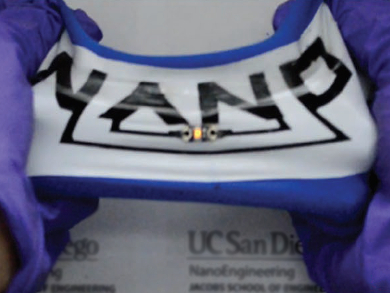Stretchable electronics could be used in textiles or medical applications, for example. However, the power supply is a limiting factor so far, as batteries are usually rigid and bulky. Some stretchable batteries have been prepared, but their fabrication methods (lithography, dip coating, etc.) are expensive and low-throughput.
Ying Shirley Meng, Joseph Wang, and colleagues, University of California, San Diego, USA, have developed a highly stretchable rechargeable battery using an inexpensive printing approach. The team used a spandex base covered with polyurethane and printed a current collector onto the base using a carbon ink in a screen-printing process. The anodes were printed using a Zn ink and the cathodes were added using a silver oxide (Ag2O) ink. Between each printing step, the material was cured at 80 °C for 15 minutes.The inks form elastic composites and contain SIS (poly-styrene-block-polyisoprene-block-polystyrene) as a hyperelastic binder.
The resulting battery has the highest reversible capacity and discharge current density reported so far for an intrinsically stretchable battery. According to the researchers, the elasticity of SIS has the potential to enhance other forms of stretchable energy storage technologies.
- All-Printed, Stretchable Zn-Ag2O Rechargeable Battery via Hyperelastic Binder for Self-Powering Wearable Electronics,
Rajan Kumar, Jaewook Shin, Lu Yin, Jung-Min You, Ying Shirley Meng, Joseph Wang,
Adv. Energy Mater. 2016.
DOI: 10.1002/aenm.201602096




